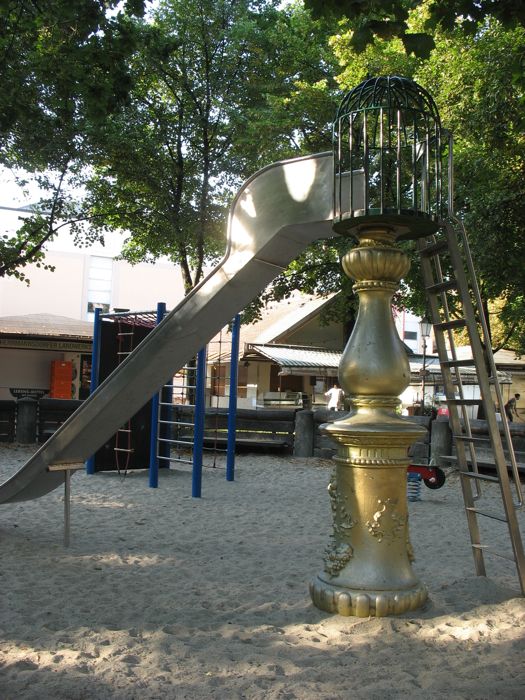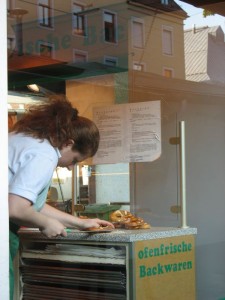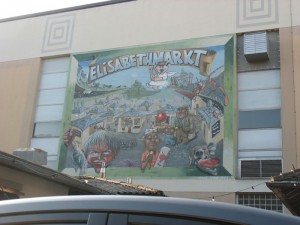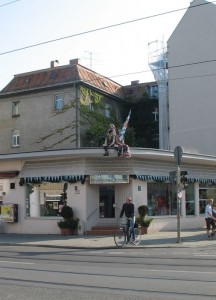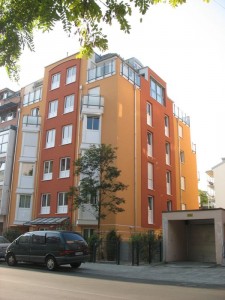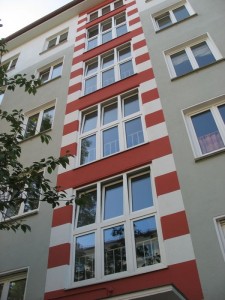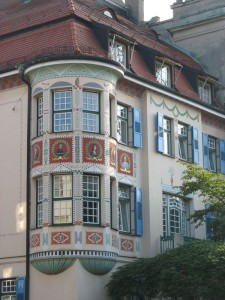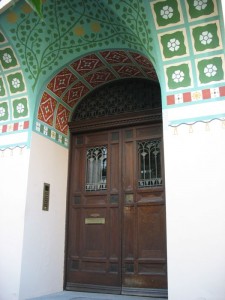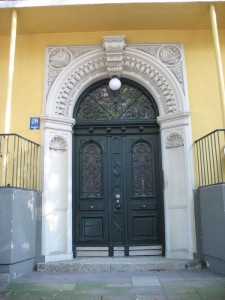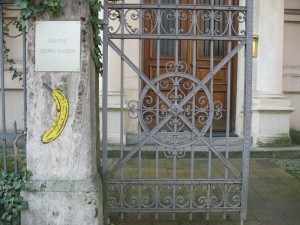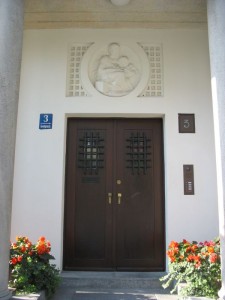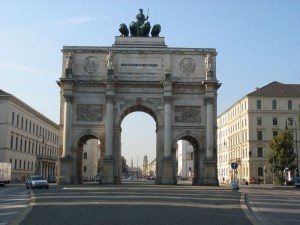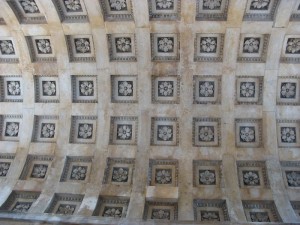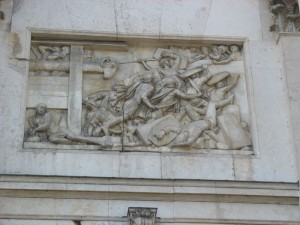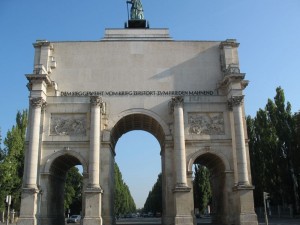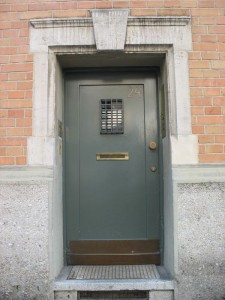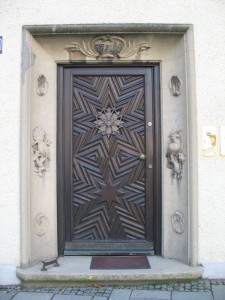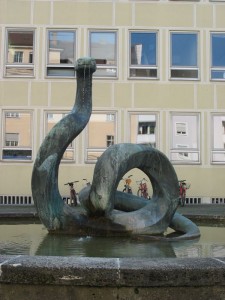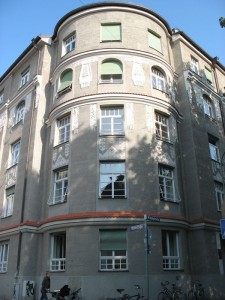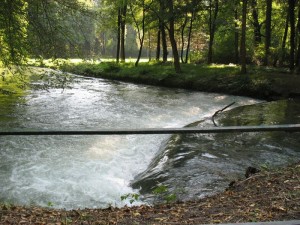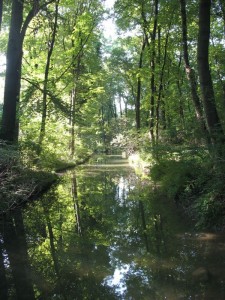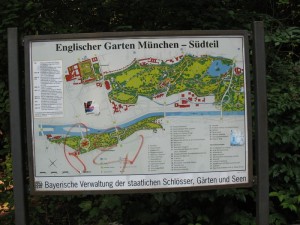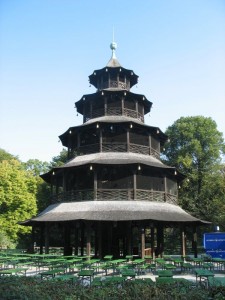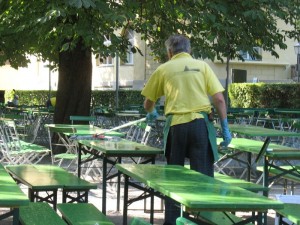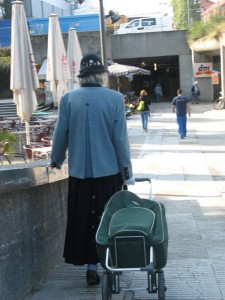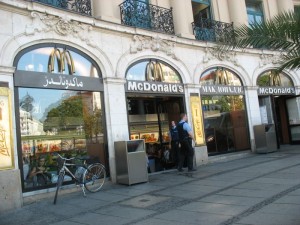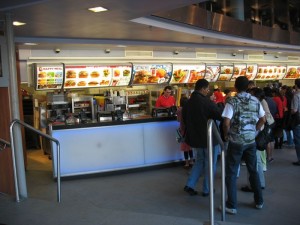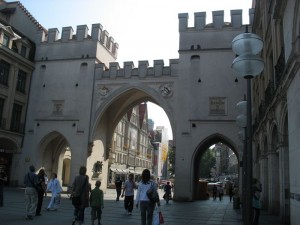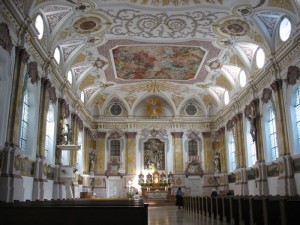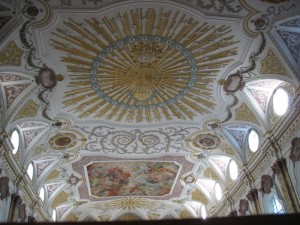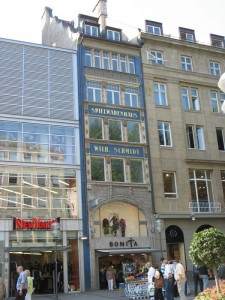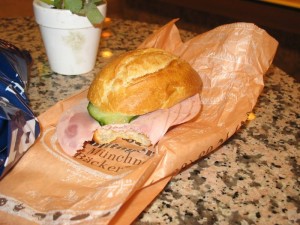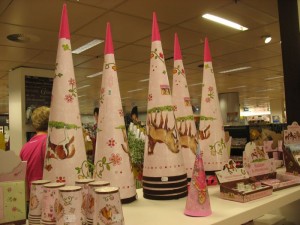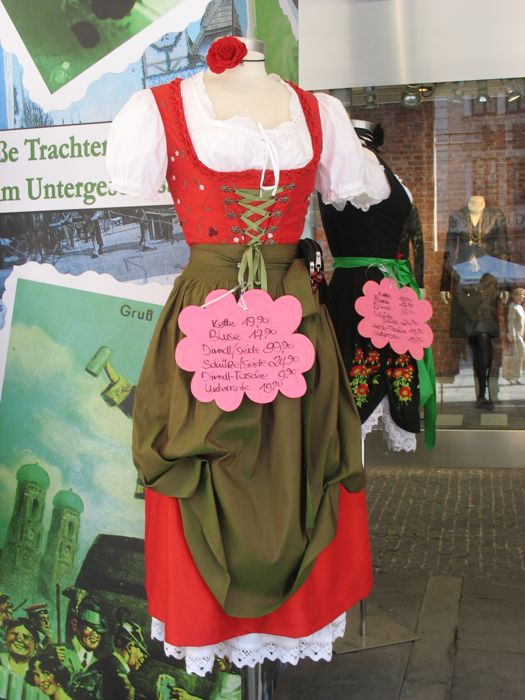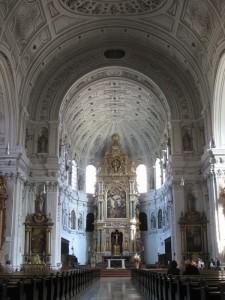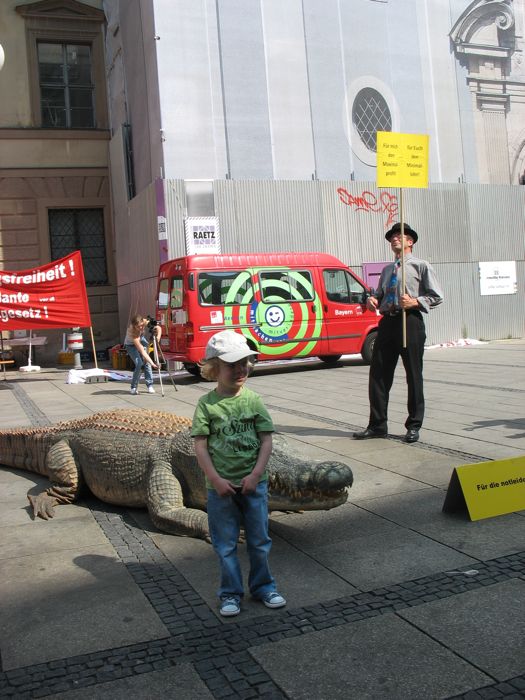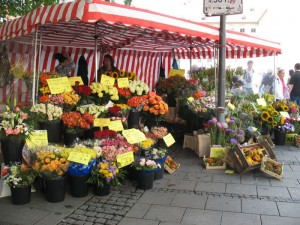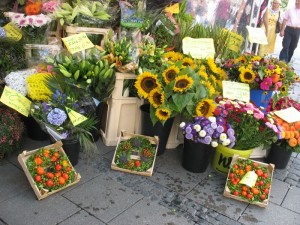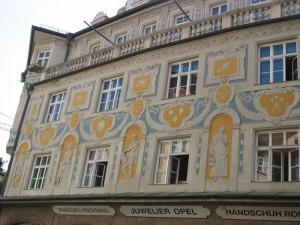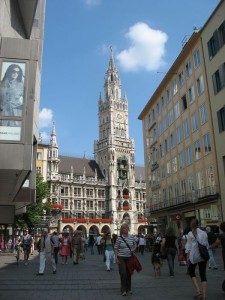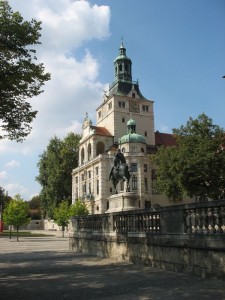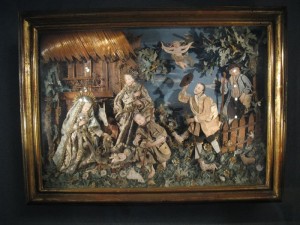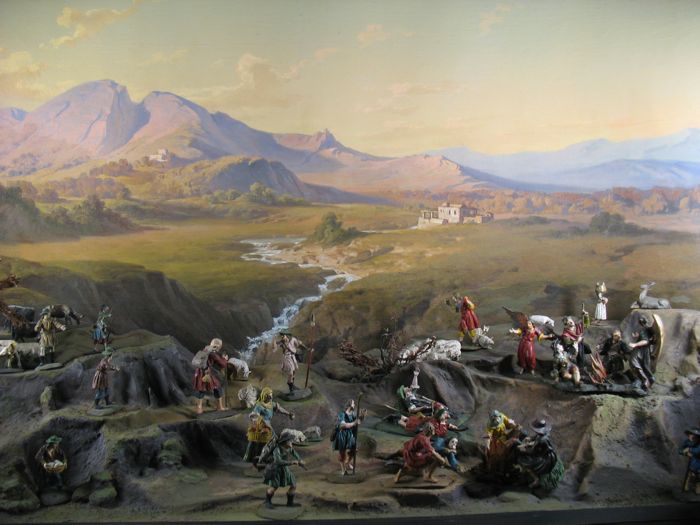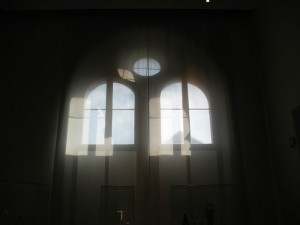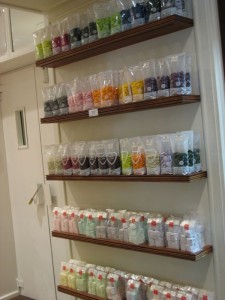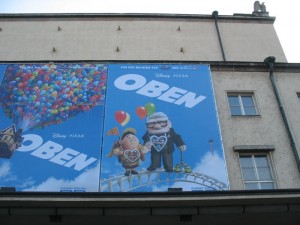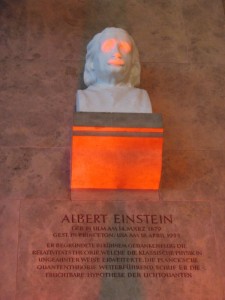I awake to hear Dave practicing his talk in the bathroom–we’re all up early today. He’s off by 7:30 a.m. and I see him at breakfast just as he’s leaving to go and load his presentation. I hurry and eat and then I’m out by 8:10–probably the earliest yet. That’s how it is on the last days of a trip–it’s rush rush to try and cram the sightseeing in. I take the Bus 100 (I will be REALLY glad when they finish the streetcars, but then again, it doesn’t matter because I won’t be here) to the subway stop Odeonplatz. Then catch the U3/U6 train to Karlsplatz, get off and grab the streetcar/tram 27 (Peturing–the trams are working up here) to Elizabethplatz. I want to see my namesake plaza.
Okay. Disappointment. I see this lovely golden painted slide, a tiny playground, a teensy market where nothing is open. That was a bust.
This young woman is getting ready for the day by slicing open the bretzels. She’ll butter them, then put them back together and sell them for a snack.
Time to move on down the street. I think I’d like to head over to the Siegestor next, whatever it is.
This is on the next corner. Yes, it’s a shop that sells dirndls and traditional clothing, but they have mannequins atop the roof, as an advertisement. It’s interesting to walk down the streets here, as the buildings look so different to me. I like the paint colors, the patterns, and the unique little touches that make this place so Munich-y, if there is such a word.
This doorway belongs to the building just above it. Like any tourist, I snap a few photos of the doorways.
The decor just makes this one–elegant door, elegant gate, banana. . .
Beautiful plasterwork of a mother and a child. If my crude reading of the sign on the gate outside says anything, this is a clinic for mothers.
So, I see the gate, which I think is one of the gates of the city. It’s not. It’s the Siegestor, or Victory Gate. According to Wikipedia: it is a “three-arched triumphal arch crowned with a statue of Bavaria with a lion-quadriga.” Okay. Then it dawns on my that I can see my favorite yellow church through the arch, and all of a sudden, I have my bearings. The arch is in the middle of the street, so I dodge the traffic over to take a look at it.
Looking up into the arch, with its coffered ceiling.
Requisite carving of someone getting creamed in battle.
It wasn’t until I got home that I was able to find out what the words meant. Wikipedia again: “The gate was originally dedicated to the glory of the Bavarian army (dem bayerischen Heere zum Ruhme). Today the Siegestor is a monument and reminder to peace. After sustaining heavy damage in World War II, the gate was reconstructed and restored only partially. The inscription on the back side is by Wilhelm Hausenstein and reads Dem Sieg geweiht, vom Krieg zerstört, zum Frieden mahnend, which translates as “Dedicated to victory, destroyed by war, reminding of peace.”
It’s quiet, and I’m the only one there.
I head to the left, through the area around the university, finding more doors, more interesting sights on my way to the English Garden
It’s the symmetry and balance of this door–I’m sure it’s a type of architecture style that is quite well known, just not by me.
Snake Fountain in front of the optometry school. Add this to the category of Fountains That Squirt Something.
Just before I entered the Englischer Garten (English Garden) was this lovely half-round building, with elegant plaster medallions.
The English Garden is a large park in Munich, larger than New York’s Central Park. The name comes from the type of garden that it is: an English garden, with informal landscaping. It’s an oasis in the city, but popular.
I made my way, via my tourist maps and an occasional posted map, to this: The Chiniesischer Turm, or Chinese Tower.
The staff was cleaning up from the night before, obviously, and I liked the approach: squeegee mops on the tables. At the base of the Chinese Tower is a huge beer garden that seats 7,000–Munich’s second largest. I guess the largest is the Oktoberfest site.
I hop back on Bus 54, hoping it goes somewhere close to a subway. I ask this lady for directions to the U-bahn, and they point me towards this tunnel. It goes like this “Ooo-bahn?” and a shrug of the shoulders, my finger on a map of the underground system. She gives me several sentences in German, nods her head and heads off. I follow and the tunnel leads to the station.So, Ubahn to Odeonsplatz and U4/U5 to Karlsplatz. As long as I don’t have to talk, I’ll can probably get there.
Below, the tile work in the Karlsplatz station.
I was heading for a five-story toy store in the Karlsplatz area, but it turned out to only have two stories, and I couldn’t justify the cost of buying something for the grandchildren after factoring in the conversion rate of the euro to the dollar.
I found the McDonald’s next door, with its Happy Meals. Unfortunately, it was packed.
Through Karls Tor (Karls Gate–one of the existing gates of the city) again, up Neuhauser street, where I’m hoping to find lunch, see a few more sights. Oh let’s be real. I want to buy more chocolate to bring home AND sight-see.
This is Burgersaalkirke, and you walk up from the street level to reach this. It feels like a worship space, although first constructed as Citizen’s Hall. Like just about everything else in this city, it was destroyed in the war (only the facade remained standing), and reconstructed.
This street has no cars, only pedestrian traffic and in between all the more modern buildings, you can find little gems like this one.
Lunch was basic–in the basement of Karstadt. But up one level is the chocolate area–a huge “room” full of nothing but chocolate. They take their chocolate seriously.
Maybe not only chocolate. These were Schultüte or “first day of school” cones, that are filled with candies, little prizes and given to the children on their first day of school. The KinderCone website explains: “When first graders in Germany and Austria set off on their first day of school, their families reward them with a large, colorful cone filled with treats, school supplies and gifts. For all the children who have eagerly awaited this moment since pre-school, the presentation of their very own Schultüte is a wonderful way to begin their year of first grade One.” She continues:
“It also brought back these youthful sentiments of pride and starting something that was almost bigger than oneself. That part of growing up and realizing that a new chapter of childhood was about to begin stuck with me. Like so many others I distinctly remember the contents of my Kindercone; the delicious chocolates bars (Kinder Chocolate as it was called), the amazingly yellow zippered pencil case, and my first fountain pen, manufactured by the German company Pelikan. It was blue and silver on the top and I remember being so proud of my future assignment: First Grader, first writer and reader. The ownership of a fountain pen really was the stepping point into adulthood, albeit far away on that morning in Frau Hauptmann’s classroom filled to the rim with 30 sweaty, anxious First Graders.”
A lovely tradition, I think.
Up the street was this dirndl with all the parts labeled and priced.
I’m determined to hit every church I can, for who knows when I’ll ever come back to Munich? This one is St. Michael’s.
Outside was a political rally–where this young child bravely stood by the alligator that was crawline around. I think it was remote controlled, but it was frightening at first.
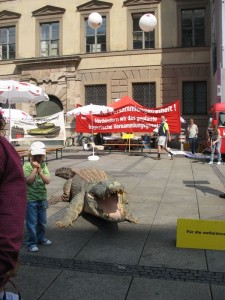 The rally was for labor unions–for more reasonable vacation hours, more benefits, better pay. I watched for a while and then was approached by a woman handing out pamphlets. I asked her what it was about (she spoke English to me). She explained, and I said, “Perhaps we need something like this in the United States.”
The rally was for labor unions–for more reasonable vacation hours, more benefits, better pay. I watched for a while and then was approached by a woman handing out pamphlets. I asked her what it was about (she spoke English to me). She explained, and I said, “Perhaps we need something like this in the United States.”
“But you have Mr. Obama!” she said.
I realized that her view of what our new President could do was so very different than what I thought he could do, given the constraints of a hostile political climate, the machinations of Congress, and generally how our system of laws was enacted. It was an eye-opener to hear her talk, and others like her, who would engage me on this subject. Everywhere I went it was so different than before. Previously everyone wanted to know what I thought of President Bush, and most Europeans that I had talked to in the past had their own (not positive) views about him. But now–every one seemed to be in sort of a congratulatory mood–you Americans pulled it off, they seemed to say. You elected Barack Obama. Because of this, I understood why he was awarded the Nobel Peace Prize. He had changed the “climate”–America’s bravura and seemingly macho approach to the world was now more reasonable.
A flower stand in the street.
I’m getting tired now, and am looking to head back to the hotel for a break. Down one street to see this lovely plasterwork facade, then a view (below) of the New Rathaus, elegant in the sunlight.
I retrace my steps (U-bahn to bus to hotel) and take a much needed short nap–long enough to refresh me so I can head out for one last touristy thing this day: Bayerisches Nationalmuseum, or the Bavarian National Museum.
I pay the entrance fee and they steer me downstairs to the Nativity Scenes and Creches. I take their hint. Many scenes are carved of wood, like this one. Some are made of paper, others are dolls dressed in the style of the times. The collection is enormous and dimly lit to preserve it, otherwise I’d have more photos.
The whole ground floor on this side appears to be nativity scene after nativity, but it different formats than the traditional small creche that we see in the States. The one above was enormous, with a painted backdrop and molded stage. Several nativities were life size, and others were very tiny. One was made completely of paper–I’d say there were nearly a hundred different figurines in there–and others were minuscule, the figures no larger than a finger.
My favorite by far was one where Joseph was knocking at the inn door, the light falling in a soft wedge across the town square, illuminating Mary, who was sitting, waiting, hunched on the edge of the fountain. I can see why the nobility liked having these in their homes–I could imagine Mary’s plight so much more clearly after looking at this scene.
From the museum website:
The museum houses the artistically most valuable and extensive crib collection in the world. Three geographical focal points characterise the collection, which contains more than 60 illusionistically designed crib images: the Alps, Naples and Sicily. Primarily, many-figured nativity scenes, which were created between 1700 and the middle of the 19th Century are on display. The cribs stem not only from churches, but inter alia, also from the Neapolitan court and the property of the Neapolitan nobility.It’s in German-translated-into-English, if you’re wondering. The German name for these is Krippen. By the way, a traveling exhibit of this was heralded in the New York Times in 1908, so yes, they’ve been around a while.
I wandered through the rest of the museum, finally leaving when the screaming from a young child got to me. This family–and I–were the only ones there, and I wondered why they let him scream and scream. They also were tourists, from India. I did get to see this ethereal window, though.
I went to Kafer on my way home, in order to pick up a lime green shopping bag, and snapped a photo of these candies all lined up, with marshmellows all aligned below. I wish I had lots more room in my suitcase!
Then Dave and I headed down to the reception for all the scientists at his meeting, and on the way, we passed by the advertisement for the movie “Up.” We laughed that the main characters had the cookie hearts around their necks. The reception was held in the Deutsches Museum, in an upper room overlooking the main courtyard. They served us drinks, and I enjoyed that apple cider drink again, while we waited for the German equivalent to the Secretary of State to arrive.
The room had busts of many favorite scientists around the room, with a caption identifying them. For some reason, they were uplit in bright orange light, giving Einstein a spooky glow just in time for Halloween. In a flurry, she arrived and we were distributed English tracts of her speech; she delivered it in German. After she spoke, they broke out the hor’douvres and desserts. That was enough dinner for us, so we headed home. I blogged some, answered email and was able to get to bed at a normal hour. Yay!
